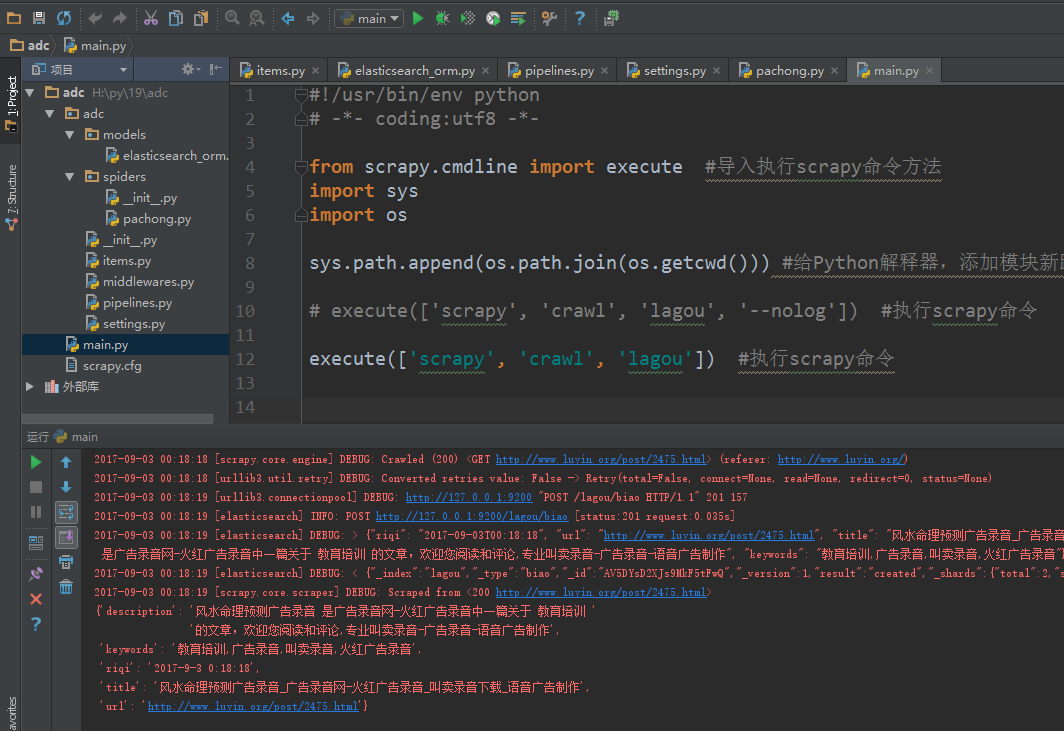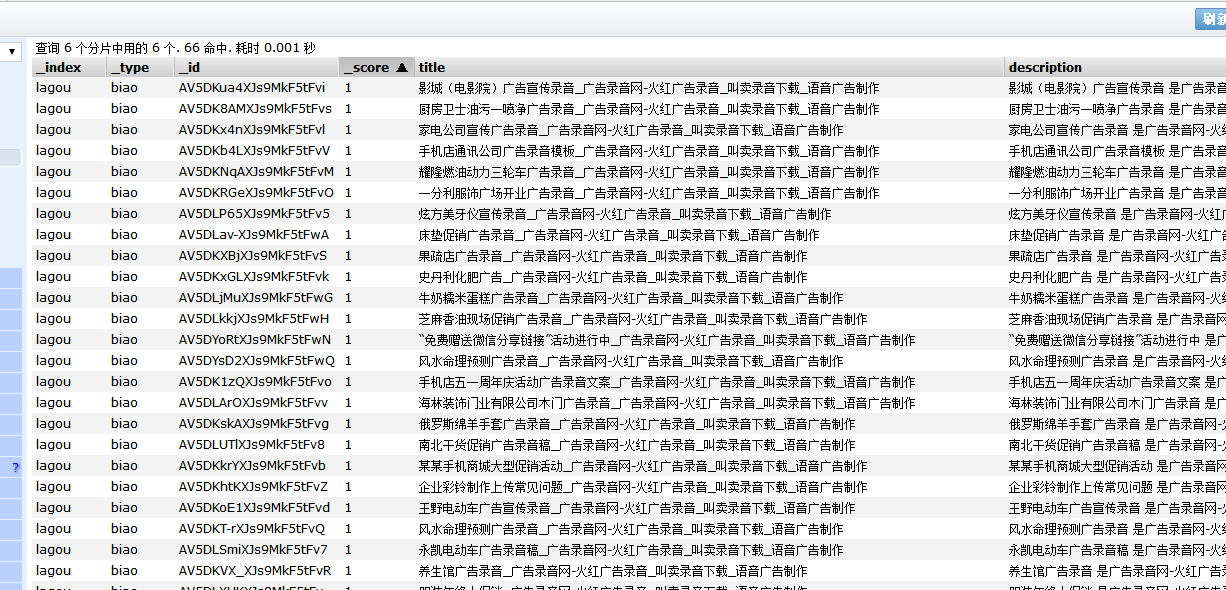四十六 Python分布式爬虫打造搜索引擎Scrapy精讲—elasticsearch(搜索引擎)scrapy写入数据到elasticsearch中
前面我们讲到的elasticsearch(搜索引擎)操作,如:增、删、改、查等操作都是用的elasticsearch的语言命令,就像sql命令一样,当然elasticsearch官方也提供了一个python操作elasticsearch(搜索引擎)的接口包,就像sqlalchemy操作数据库一样的ORM框,这样我们操作elasticsearch就不用写命令了,用elasticsearch-dsl-py这个模块来操作,也就是用python的方式操作一个类即可
elasticsearch-dsl-py下载
下载地址:https://github.com/elastic/elasticsearch-dsl-py
文档说明:http://elasticsearch-dsl.readthedocs.io/en/latest/
首先安装好elasticsearch-dsl-py模块
1、elasticsearch-dsl模块使用说明
create_connection(hosts=['127.0.0.1']):连接elasticsearch(搜索引擎)服务器方法,可以连接多台服务器
class Meta:设置索引名称和表名称
索引类名称.init(): 生成索引和表以及字段
实例化索引类.save():将数据写入elasticsearch(搜索引擎)
elasticsearch_orm.py 操作elasticsearch(搜索引擎)文件

#!/usr/bin/env python
# -*- coding:utf8 -*-
from datetime import datetime
from elasticsearch_dsl import DocType, Date, Nested, Boolean, \
analyzer, InnerObjectWrapper, Completion, Keyword, Text, Integer # 更多字段类型见第三百六十四节elasticsearch(搜索引擎)的mapping映射管理 from elasticsearch_dsl.connections import connections # 导入连接elasticsearch(搜索引擎)服务器方法
connections.create_connection(hosts=['127.0.0.1']) class lagouType(DocType): # 自定义一个类来继承DocType类
# Text类型需要分词,所以需要知道中文分词器,ik_max_wordwei为中文分词器
title = Text(analyzer="ik_max_word") # 设置,字段名称=字段类型,Text为字符串类型并且可以分词建立倒排索引
description = Text(analyzer="ik_max_word")
keywords = Text(analyzer="ik_max_word")
url = Keyword() # 设置,字段名称=字段类型,Keyword为普通字符串类型,不分词
riqi = Date() # 设置,字段名称=字段类型,Date日期类型 class Meta: # Meta是固定写法
index = "lagou" # 设置索引名称(相当于数据库名称)
doc_type = 'biao' # 设置表名称 if __name__ == "__main__": # 判断在本代码文件执行才执行里面的方法,其他页面调用的则不执行里面的方法
lagouType.init() # 生成elasticsearch(搜索引擎)的索引,表,字段等信息 # 使用方法说明:
# 在要要操作elasticsearch(搜索引擎)的页面,导入此模块
# lagou = lagouType() #实例化类
# lagou.title = '值' #要写入字段=值
# lagou.description = '值'
# lagou.keywords = '值'
# lagou.url = '值'
# lagou.riqi = '值'
# lagou.save() #将数据写入elasticsearch(搜索引擎)

2、scrapy写入数据到elasticsearch中
爬虫文件

# -*- coding: utf-8 -*-
import scrapy
from scrapy.linkextractors import LinkExtractor
from scrapy.spiders import CrawlSpider, Rule
from adc.items import LagouItem,LagouItemLoader #导入items容器类,和ItemLoader类
import time class LagouSpider(CrawlSpider): #创建爬虫类
name = 'lagou' #爬虫名称
allowed_domains = ['www.luyin.org'] #起始域名
start_urls = ['http://www.luyin.org/'] #起始url custom_settings = {
"AUTOTHROTTLE_ENABLED": True, #覆盖掉settings.py里的相同设置,开启COOKIES
"DOWNLOAD_DELAY":5
} rules = (
#配置抓取列表页规则
Rule(LinkExtractor(allow=('ggwa/.*')), follow=True), #配置抓取内容页规则
Rule(LinkExtractor(allow=('post/\d+.html.*')), callback='parse_job', follow=True),
) def parse_job(self, response): #回调函数,注意:因为CrawlS模板的源码创建了parse回调函数,所以切记我们不能创建parse名称的函数
atime = time.localtime(time.time()) #获取系统当前时间
dqatime = "{0}-{1}-{2} {3}:{4}:{5}".format(
atime.tm_year,
atime.tm_mon,
atime.tm_mday,
atime.tm_hour,
atime.tm_min,
atime.tm_sec
) # 将格式化时间日期,单独取出来拼接成一个完整日期 url = response.url item_loader = LagouItemLoader(LagouItem(), response=response) # 将数据填充进items.py文件的LagouItem
item_loader.add_xpath('title', '/html/head/title/text()')
item_loader.add_xpath('description', '/html/head/meta[@name="Description"]/@content')
item_loader.add_xpath('keywords', '/html/head/meta[@name="keywords"]/@content')
item_loader.add_value('url', url)
item_loader.add_value('riqi', dqatime)
article_item = item_loader.load_item()
yield article_item

items.py文件

# -*- coding: utf-8 -*- # Define here the models for your scraped items
#
# See documentation in:
# http://doc.scrapy.org/en/latest/topics/items.html
#items.py,文件是专门用于,接收爬虫获取到的数据信息的,就相当于是容器文件 import scrapy
from scrapy.loader.processors import MapCompose,TakeFirst
from scrapy.loader import ItemLoader #导入ItemLoader类也就加载items容器类填充数据
from adc.models.elasticsearch_orm import lagouType #导入elasticsearch操作模块 class LagouItemLoader(ItemLoader): #自定义Loader继承ItemLoader类,在爬虫页面调用这个类填充数据到Item类
default_output_processor = TakeFirst() #默认利用ItemLoader类,加载items容器类填充数据,是列表类型,可以通过TakeFirst()方法,获取到列表里的内容 def tianjia(value): #自定义数据预处理函数
return value #将处理后的数据返给Item class LagouItem(scrapy.Item): #设置爬虫获取到的信息容器类
title = scrapy.Field( #接收爬虫获取到的title信息
input_processor=MapCompose(tianjia), #将数据预处理函数名称传入MapCompose方法里处理,数据预处理函数的形式参数value会自动接收字段title
)
description = scrapy.Field()
keywords = scrapy.Field()
url = scrapy.Field()
riqi = scrapy.Field() def save_to_es(self):
lagou = lagouType() # 实例化elasticsearch(搜索引擎对象)
lagou.title = self['title'] # 字段名称=值
lagou.description = self['description']
lagou.keywords = self['keywords']
lagou.url = self['url']
lagou.riqi = self['riqi']
lagou.save() # 将数据写入elasticsearch(搜索引擎对象)
return

pipelines.py文件

# -*- coding: utf-8 -*- # Define your item pipelines here
#
# Don't forget to add your pipeline to the ITEM_PIPELINES setting
# See: http://doc.scrapy.org/en/latest/topics/item-pipeline.html
from adc.models.elasticsearch_orm import lagouType #导入elasticsearch操作模块 class AdcPipeline(object):
def process_item(self, item, spider): #也可以在这里将数据写入elasticsearch搜索引擎,这里的缺点是统一处理
# lagou = lagouType()
# lagou.title = item['title']
# lagou.description = item['description']
# lagou.keywords = item['keywords']
# lagou.url = item['url']
# lagou.riqi = item['riqi']
# lagou.save()
item.save_to_es() #执行items.py文件的save_to_es方法将数据写入elasticsearch搜索引擎
return item

settings.py文件,注册pipelines
# Configure item pipelines
# See http://scrapy.readthedocs.org/en/latest/topics/item-pipeline.html
ITEM_PIPELINES = {
'adc.pipelines.AdcPipeline': 300,
}
main.py爬虫启动文件

#!/usr/bin/env python
# -*- coding:utf8 -*- from scrapy.cmdline import execute #导入执行scrapy命令方法
import sys
import os sys.path.append(os.path.join(os.getcwd())) #给Python解释器,添加模块新路径 ,将main.py文件所在目录添加到Python解释器 execute(['scrapy', 'crawl', 'lagou', '--nolog']) #执行scrapy命令 # execute(['scrapy', 'crawl', 'lagou']) #执行scrapy命令

运行爬虫

写入elasticsearch(搜索引擎)情况

补充:elasticsearch-dsl 的 增删改查

#!/usr/bin/env python
# -*- coding:utf8 -*-
from datetime import datetime
from elasticsearch_dsl import DocType, Date, Nested, Boolean, \
analyzer, InnerObjectWrapper, Completion, Keyword, Text, Integer # 更多字段类型见第三百六十四节elasticsearch(搜索引擎)的mapping映射管理 from elasticsearch_dsl.connections import connections # 导入连接elasticsearch(搜索引擎)服务器方法
connections.create_connection(hosts=['127.0.0.1']) class lagouType(DocType): # 自定义一个类来继承DocType类
# Text类型需要分词,所以需要知道中文分词器,ik_max_wordwei为中文分词器
title = Text(analyzer="ik_max_word") # 设置,字段名称=字段类型,Text为字符串类型并且可以分词建立倒排索引
description = Text(analyzer="ik_max_word")
keywords = Text(analyzer="ik_max_word")
url = Keyword() # 设置,字段名称=字段类型,Keyword为普通字符串类型,不分词
riqi = Date() # 设置,字段名称=字段类型,Date日期类型 class Meta: # Meta是固定写法
index = "lagou" # 设置索引名称(相当于数据库名称)
doc_type = 'biao' # 设置表名称 if __name__ == "__main__": # 判断在本代码文件执行才执行里面的方法,其他页面调用的则不执行里面的方法
lagouType.init() # 生成elasticsearch(搜索引擎)的索引,表,字段等信息 # 使用方法说明:
# 在要要操作elasticsearch(搜索引擎)的页面,导入此模块
# lagou = lagouType() #实例化类
# lagou.title = '值' #要写入字段=值
# lagou.description = '值'
# lagou.keywords = '值'
# lagou.url = '值'
# lagou.riqi = '值'
# lagou.save() #将数据写入elasticsearch(搜索引擎)

1新增数据

from adc.models.elasticsearch_orm import lagouType #导入刚才配置的elasticsearch操作模块 lagou = lagouType() # 实例化elasticsearch(搜索引擎对象)
lagou._id = 1 #自定义ID,很重要,以后都是根据ID来操作
lagou.title = self['title'] # 字段名称=值
lagou.description = self['description']
lagou.keywords = self['keywords']
lagou.url = self['url']
lagou.riqi = self['riqi']
lagou.save() # 将数据写入elasticsearch(搜索引擎对象)

2删除指定数据
from adc.models.elasticsearch_orm import lagouType #导入刚才配置的elasticsearch操作模块
sousuo_orm = lagouType() # 实例化
sousuo_orm.get(id=1).delete() # 删除id等于1的数据
3修改指定的数据
from adc.models.elasticsearch_orm import lagouType #导入刚才配置的elasticsearch操作模块 sousuo_orm = lagouType() # 实例化
sousuo_orm.get(id=1).update(title='123456789') # 修改id等于1的数据
以上全部使用elasticsearch-dsl模块
注意下面使用的原生elasticsearch模块
删除指定使用,就是相当于删除指定数据库
使用原生elasticsearch模块删除指定索引

from elasticsearch import Elasticsearch # 导入原生的elasticsearch(搜索引擎)接口
client = Elasticsearch(hosts=settings.Elasticsearch_hosts) # 连接原生的elasticsearch # 使用原生elasticsearch模块删除指定索引
#要做容错处理,如果索引不存在会报错
try:
client.indices.delete(index='jxiou_zuopin')
except Exception as e:
pass

原生查询

from elasticsearch import Elasticsearch # 导入原生的elasticsearch(搜索引擎)接口
client = Elasticsearch(hosts=Elasticsearch_hosts) # 连接原生的elasticsearch response = client.search( # 原生的elasticsearch接口的search()方法,就是搜索,可以支持原生elasticsearch语句查询
index="jxiou_zuopin", # 设置索引名称
doc_type="zuopin", # 设置表名称
body={ # 书写elasticsearch语句
"query": {
"multi_match": { # multi_match查询
"query": sousuoci, # 查询关键词
"fields": ["title"] # 查询字段
}
},
"from": (page - 1) * tiaoshu, # 从第几条开始获取
"size": tiaoshu, # 获取多少条数据
"highlight": { # 查询关键词高亮处理
"pre_tags": ['<span class="gaoliang">'], # 高亮开始标签
"post_tags": ['</span>'], # 高亮结束标签
"fields": { # 高亮设置
"title": {} # 高亮字段
}
}
}
)
# 开始获取数据
total_nums = response["hits"]["total"] # 获取查询结果的总条数 hit_list = [] # 设置一个列表来储存搜索到的信息,返回给html页面 for hit in response["hits"]["hits"]: # 循环查询到的结果
hit_dict = {} # 设置一个字典来储存循环结果
if "title" in hit["highlight"]: # 判断title字段,如果高亮字段有类容
hit_dict["title"] = "".join(hit["highlight"]["title"]) # 获取高亮里的title
else:
hit_dict["title"] = hit["_source"]["title"] # 否则获取不是高亮里的title hit_dict["id"] = hit["_source"]["nid"] # 获取返回nid # 加密样音地址
hit_dict["yangsrc"] = jia_mi(str(hit["_source"]["yangsrc"])) # 获取返回yangsrc hit_list.append(hit_dict)

四十六 Python分布式爬虫打造搜索引擎Scrapy精讲—elasticsearch(搜索引擎)scrapy写入数据到elasticsearch中的更多相关文章
- 三十六 Python分布式爬虫打造搜索引擎Scrapy精讲—利用开源的scrapy-redis编写分布式爬虫代码
scrapy-redis是一个可以scrapy结合redis搭建分布式爬虫的开源模块 scrapy-redis的依赖 Python 2.7, 3.4 or 3.5,Python支持版本 Redis & ...
- 四十九 Python分布式爬虫打造搜索引擎Scrapy精讲—elasticsearch(搜索引擎)用Django实现搜索结果分页
逻辑处理函数 计算搜索耗时 在开始搜索前:start_time = datetime.now()获取当前时间 在搜索结束后:end_time = datetime.now()获取当前时间 last_t ...
- 四十八 Python分布式爬虫打造搜索引擎Scrapy精讲—elasticsearch(搜索引擎)用Django实现搜索功能
Django实现搜索功能 1.在Django配置搜索结果页的路由映射 """pachong URL Configuration The `urlpatterns` lis ...
- 二十六 Python分布式爬虫打造搜索引擎Scrapy精讲—通过downloadmiddleware中间件全局随机更换user-agent浏览器用户代理
downloadmiddleware介绍中间件是一个框架,可以连接到请求/响应处理中.这是一种很轻的.低层次的系统,可以改变Scrapy的请求和回应.也就是在Requests请求和Response响应 ...
- 四十五 Python分布式爬虫打造搜索引擎Scrapy精讲—elasticsearch(搜索引擎)的bool组合查询
bool查询说明 filter:[],字段的过滤,不参与打分must:[],如果有多个查询,都必须满足[并且]should:[],如果有多个查询,满足一个或者多个都匹配[或者]must_not:[], ...
- 四十二 Python分布式爬虫打造搜索引擎Scrapy精讲—elasticsearch(搜索引擎)的mget和bulk批量操作
注意:前面讲到的各种操作都是一次http请求操作一条数据,如果想要操作多条数据就会产生多次请求,所以就有了mget和bulk批量操作,mget和bulk批量操作是一次请求可以操作多条数据 1.mget ...
- 第三百六十四节,Python分布式爬虫打造搜索引擎Scrapy精讲—elasticsearch(搜索引擎)的mapping映射管理
第三百六十四节,Python分布式爬虫打造搜索引擎Scrapy精讲—elasticsearch(搜索引擎)的mapping映射管理 1.映射(mapping)介绍 映射:创建索引的时候,可以预先定义字 ...
- 第三百五十四节,Python分布式爬虫打造搜索引擎Scrapy精讲—数据收集(Stats Collection)
第三百五十四节,Python分布式爬虫打造搜索引擎Scrapy精讲—数据收集(Stats Collection) Scrapy提供了方便的收集数据的机制.数据以key/value方式存储,值大多是计数 ...
- 第三百四十四节,Python分布式爬虫打造搜索引擎Scrapy精讲—craw母版l创建自动爬虫文件—以及 scrapy item loader机制
第三百四十四节,Python分布式爬虫打造搜索引擎Scrapy精讲—craw母版l创建自动爬虫文件—以及 scrapy item loader机制 用命令创建自动爬虫文件 创建爬虫文件是根据scrap ...
随机推荐
- 剑指Offer——二维数组中的查找
题目描述: 在一个二维数组中,每一行都按照从左到右递增的顺序排序,每一列都按照从上到下递增的顺序排序.请完成一个函数,输入这样的一个二维数组和一个整数,判断数组中是否含有该整数. 分析: 因为二维数组 ...
- Line---CodeForces 7C(扩展欧几里得算法)
题目链接:http://codeforces.com/problemset/problem/7/C AX+BY=C已知 A B C 求 X Y: #include <iostream> # ...
- rest_framework之url控制器详解
一 自定义路由(原始方式) from django.conf.urls import url from app01 import views urlpatterns = [ url(r'^books/ ...
- Flask(1)- 主流web框架、初识flask
一.Python 现阶段三大主流Web框架 Django.Tornado.Flask 对比 Django 主要特点是大而全,集成了很多组件(例如Models.Admin.Form等等), 不管你用得到 ...
- 006-基于hyperledger fabric1.4( 官方文档)编写第一个应用【外部nodejs调用】
一.概述 官方原文地址 Writing Your First Application如果对fabric网络的基本运行机制不熟悉的话,请看这里. 注意:本教程是对fabric应用以及如何使用智能合约的简 ...
- ps 和 grep 查找消除 grep自身查找(转载)
用ps -def | grep查找进程很方便,最后一行总是会grep自己. $ ps -def | grep dragonfly-framework dean 5273 5272 0 15:23 pt ...
- vue生命周期以及vue的计算属性
一.Vue生命周期(vue实例从创建到销毁的过程,称为生命周期,共有八个阶段) 1.beforeCreate :在实例初始化之后,数据观测 (data observer) 和 event/watche ...
- Python(输入、输出;简单运算符;流程控制;转译)
一 输入输出 python3中统一都是input,python2中有raw_input等同于python3的input,另外python2中也有input 1.res=input("pyth ...
- EXSITS应该怎么用?
无论是做项目还是普通使用SQL,我们通常都会使用IN.因为很好理解,也很方便.但是,面对着多层查询嵌套,或者IN关键字里面的结果集数量巨大,查询的效率就会直线下降.这时候,我们应该用好EXSITS. ...
- [笔记]WiX制作msi安装包的例子
WiX是制作msi安装文件的工具,看了半天文档,感觉没有什么比一个例子更简单粗暴的了. <?xml version="1.0" encoding="UTF-8&qu ...
